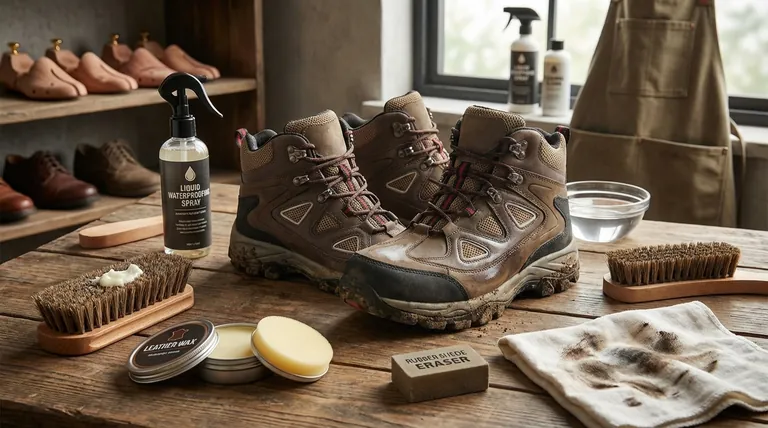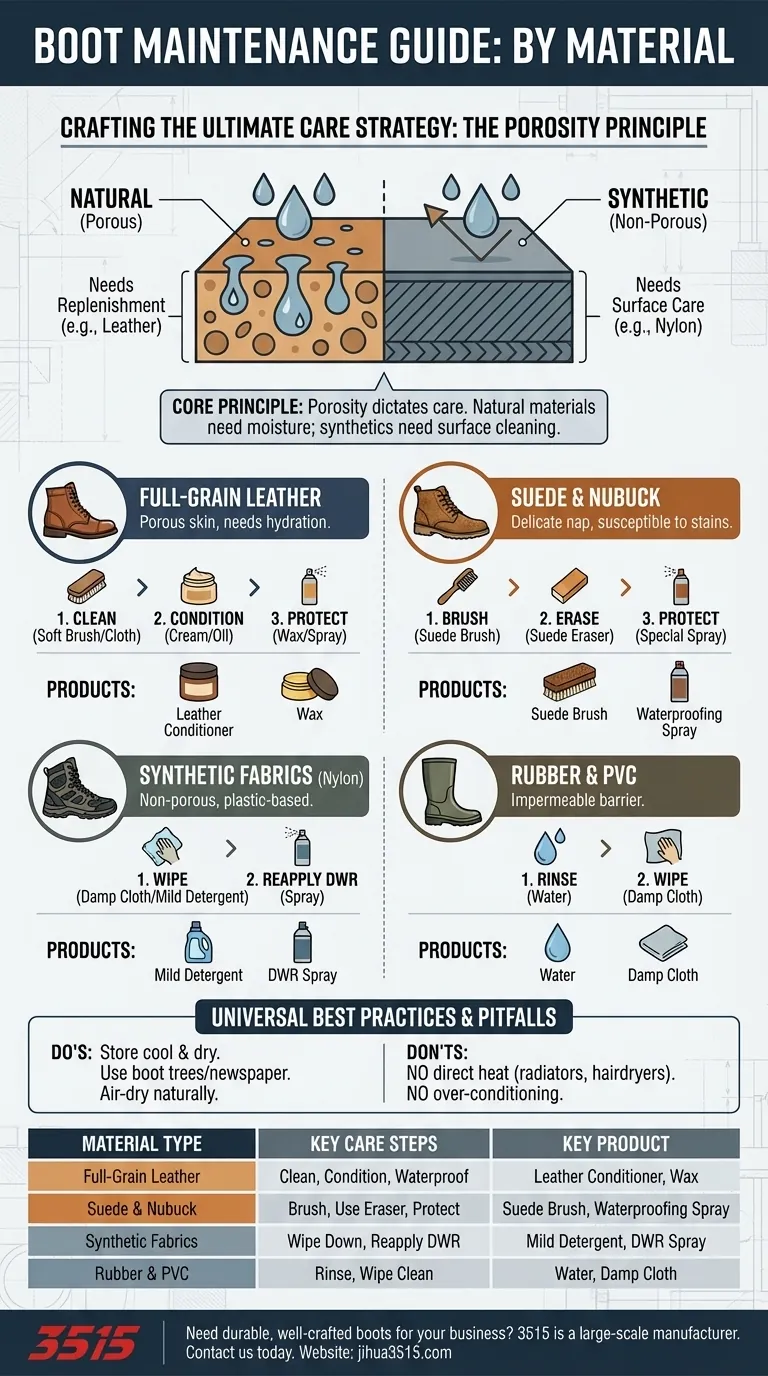Okay, so I'm thinking I need to approach this as a trusted advisor, not just a fact regurgitator. The user's an expert, so I've got to give them something truly insightful. My strategy is to first answer their immediate question, but then, and this is crucial, explain why the answer is the way it is. I'm going to start with a bold opening hook to get their attention right away.
I've already analyzed the references, focusing on the core principles. There's a common thread: porosity. Natural materials, like leather and suede, are porous, absorbing moisture and needing replenishment. Synthetics, on the other hand, are non-porous, repelling water and requiring a different approach. The key is understanding this fundamental difference.
The structure is key. I'll break it down into digestible chunks. First, I'll explain the porosity principle and then detail the care for each material type (full-grain leather, suede/nubuck, synthetic fabrics, rubber/PVC). I'll also add a section on universal best practices applicable to all boots – cleaning, drying, storage, and rotation. It's not just about the material; it's about the entire boot's health.
I'm definitely going to include a "Pitfalls to Avoid" section. Over-conditioning, using direct heat, and neglecting small details – these are common mistakes that can ruin a perfectly good boot. This addresses the "why" again: understanding the consequences of improper care is just as valuable as knowing the right methods.
Finally, I'll wrap it up with actionable advice. It'll be a set of clear "if you own this, do that" steps, tailored to each material type. The closing sentence needs to be empowering. It needs to show that caring for boots is an intelligent strategy for longevity. It's about empowering the user to make informed choices. My focus is on synthesizing, not simply regurgitating, so the guide will be concise and practical, yet very helpful. To maintain different boot materials effectively, you must treat them according to their composition. Natural materials like leather require a three-step process of cleaning, conditioning, and waterproofing, while synthetics like nylon or PVC primarily need simple surface cleaning and occasional re-application of a waterproofing spray.
The core principle of boot care is dictated by the material's porosity. Natural, porous materials like leather need their moisture and oils replenished, whereas non-porous synthetic materials simply need their surfaces cleaned and protected.

The "Why": Understanding Material Properties
The most common mistake in boot care is treating all materials the same. A routine that saves a pair of rubber boots could easily ruin a pair of suede ones. The key is understanding how each material interacts with the environment, particularly with moisture and dirt.
Full-Grain & Smooth Leather
Leather is a natural skin. Like your own skin, it can dry out, crack, and become damaged if not properly cared for. Its porous nature means it absorbs moisture, which needs to be managed.
The proper routine involves three distinct steps. First, clean the surface with a soft brush or cloth to remove dirt. Second, condition the leather with a purpose-made cream or oil to restore its natural flexibility. Finally, protect it with a waterproofing spray or wax to create a barrier against moisture.
Suede & Nubuck
Suede and nubuck are also types of leather, but their surfaces have been textured, creating a delicate nap of fine fibers. This texture makes them highly susceptible to staining and water damage.
Care for these materials is focused on preservation. Use a specialized suede brush to gently remove dirt and restore the nap. For stains, a suede eraser can be effective. Avoid conditioners and waxes, as they will ruin the texture; instead, rely on a waterproofing spray designed specifically for suede and nubuck.
Synthetic Fabrics (Nylon, Polyester)
Most modern tactical and hiking boots use synthetic fabrics like nylon. These materials are essentially plastics; they are non-porous and do not absorb water.
Maintenance is straightforward and focuses on surface care. Wipe down the fabric with a damp cloth and mild detergent to remove dirt. While the fabric itself is waterproof, the seams and any durable water-repellent (DWR) coating can wear down. Reapply a waterproofing spray periodically to maintain this barrier.
Rubber & PVC
Materials like rubber and PVC are completely non-porous and impermeable. They are designed to be a total barrier against water, making them common in rain boots or "gumboots."
These are the easiest boots to maintain. A simple rinse with water or a wipe with a damp cloth is all that is required to remove mud and grime. No conditioning or special waterproofing is ever needed.
Universal Best Practices and Pitfalls
Regardless of the material, a few foundational habits and mistakes to avoid can dramatically extend the life of any boot. Adhering to these principles prevents the most common forms of damage.
The Importance of Storage
Always store boots in a cool, dry place away from direct sunlight or humidity. UV rays and high humidity can degrade both natural and synthetic materials over time.
To help boots maintain their shape and absorb residual moisture from sweat, use boot trees. If you don't have boot trees, stuffing them with newspaper is a classic and effective alternative.
Common Pitfalls to Avoid
Never use direct heat (like a radiator, campfire, or hairdryer) to dry your boots. This will crack leather, melt adhesives that hold the sole together, and can even warp synthetic components. Always let them air-dry naturally.
Avoid over-conditioning leather. While essential, using too much conditioner can make the leather too soft, clog its pores, and prevent it from breathing properly.
Making the Right Choice for Your Boots
Your maintenance routine should be a direct reflection of the materials you are trying to protect.
- If your primary focus is full-grain leather: Prioritize a routine of cleaning, conditioning, and waterproofing to preserve the material's integrity.
- If your primary focus is suede or nubuck: Focus on gentle, regular brushing and use specialized protective sprays to avoid damaging the delicate surface.
- If your primary focus is synthetic fabric boots: Keep maintenance simple with regular wipe-downs and reapply a waterproofing spray to bolster the seams and surface coating.
- If your primary focus is rubber or PVC boots: Simply rinse or wipe them clean after use, as the non-porous material requires minimal effort.
Understanding the nature of your boot's material transforms maintenance from a chore into a simple, effective strategy for lasting quality.
Summary Table:
| Material Type | Key Care Steps | Key Product Needed |
|---|---|---|
| Full-Grain Leather | Clean, Condition, Waterproof | Leather Conditioner, Wax |
| Suede & Nubuck | Brush, Use Eraser, Protect | Suede Brush, Waterproofing Spray |
| Synthetic Fabrics | Wipe Down, Reapply DWR | Mild Detergent, Waterproofing Spray |
| Rubber & PVC | Rinse, Wipe Clean | Water, Damp Cloth |
Need a reliable source for durable, well-crafted boots? As a large-scale manufacturer, 3515 produces a comprehensive range of footwear for distributors, brand owners, and bulk clients. Our production capabilities encompass all types of shoes and boots, ensuring consistent quality and durability that simplifies your maintenance routine. Contact us today to discuss your specific needs and discover how our manufacturing expertise can benefit your business.
Visual Guide

Related Products
- Safety Footwear Wholesale Manufacturer for Custom OEM/ODM Production
- Wholesale Comfort Leather Business Shoes with Dial Lacing System
- Durable Leather Safety Boots for Wholesale & Custom OEM Manufacturing
- Custom OEM Training Shoes Wholesale Manufacturer Durable & Breathable
- Durable Moc-Toe Wedge Work Boots | Wholesale Manufacturing for Brands
People Also Ask
- Is it normal to wear shoes in the house? A Guide to Hygiene, Comfort & Culture
- Do snake bite boots work? Your Ultimate Guide to Effective Snake Bite Protection
- What are the differences between steel toe, composite toe, and alloy toe Wellington boots? Choose the Right Safety Toe for Your Job
- How do safety shoes contribute to cost savings for companies? A Strategic Investment in Risk and Cost Management
- What do heavy duty boots do? Protect Your Feet in Demanding Work Environments



















